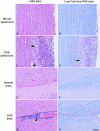Gender, age, and season at immunization uniquely influence the genetic control of susceptibility to histopathological lesions and clinical signs of experimental allergic encephalomyelitis: implications for the genetics of multiple sclerosis
- PMID: 15509529
- PMCID: PMC1618666
- DOI: 10.1016/S0002-9440(10)63416-5
Gender, age, and season at immunization uniquely influence the genetic control of susceptibility to histopathological lesions and clinical signs of experimental allergic encephalomyelitis: implications for the genetics of multiple sclerosis
Abstract
Multiple sclerosis (MS), the principal inflammatory demyelinating disease of the central nervous system (CNS), is believed to have an immunopathological etiology arising from gene-environment interactions. In this study, we examined the effect of sex, age, and season at immunization on the susceptibility of (B10.S x SJL/J) F(2) intercross mice to experimental allergic encephalomyelitis (EAE), the foremost animal model of MS. Results of logistic regression analyses suggest that female mice were more likely to exhibit CNS lesions than male mice [odds ratio (OR) = 2.28 for brain lesions; OR = 2.37 for spinal cord (SC) lesions]. Although statistically significant associations were seen between brain and SC lesions and age at the time of injection or month of injection when examined separately; these associations disappeared when controlling for sex in multiple logistic regression analyses. These results suggest that the sex of the mouse is more important in influencing the development of brain and SC lesions than was either age or month of immunization. When examining clinical disease as the endpoint, the OR for the age at immunization is 1.04, indicating that the odds of being affected increase by 4% for each increasing week of age. When controlled for age, the OR for injection in the summer months (July through September) is 1.90, suggesting that the odds of being clinically affected are 90% greater for F(2) intercross animals injected in the summercompared to those injected in the winter to spring months (February through May). In contrast to CNS lesions, the age and season at immunization significantly and independently influenced susceptibility to clinical EAE and did so equally in both males and females. Linkage analysis to eae5, the H2-linked locus controlling susceptibility to clinical disease, was performed using 6- to 12- and >12-week-old cohorts as well as summer and winter/spring cohorts of F(2) mice. Significant linkage of clinical EAE to eae5 was observed with the 6- to 12-week-old and summer populations. In contrast, linkage of clinical EAE to eae5 was not detected with the >12-week-old and winter/spring populations. These results indicate that age and seasonal effects are capable of overriding eae5-dependent genetic control of susceptibility to clinical EAE and have significant implications for the genetics of MS.
Figures

Similar articles
-
eae36, a locus on mouse chromosome 4, controls susceptibility to experimental allergic encephalomyelitis in older mice and mice immunized in the winter.Genetics. 2006 Feb;172(2):1147-53. doi: 10.1534/genetics.105.049049. Epub 2005 Nov 19. Genetics. 2006. PMID: 16299394 Free PMC article.
-
Identification of genetic loci controlling the characteristics and severity of brain and spinal cord lesions in experimental allergic encephalomyelitis.Am J Pathol. 2000 Aug;157(2):637-45. doi: 10.1016/S0002-9440(10)64574-9. Am J Pathol. 2000. PMID: 10934166 Free PMC article.
-
Adult gonadal hormones selectively regulate sexually dimorphic quantitative traits observed in experimental allergic encephalomyelitis.Am J Pathol. 2004 Jan;164(1):167-75. doi: 10.1016/S0002-9440(10)63107-0. Am J Pathol. 2004. PMID: 14695330 Free PMC article.
-
Genetics of experimental autoimmune encephalomyelitis in the mouse.Arch Immunol Ther Exp (Warsz). 2004 Sep-Oct;52(5):316-25. Arch Immunol Ther Exp (Warsz). 2004. PMID: 15507872 Review.
-
Two models of multiple sclerosis: experimental allergic encephalomyelitis (EAE) and Theiler's murine encephalomyelitis virus (TMEV) infection. A pathological and immunological comparison.Microsc Res Tech. 1995 Oct 15;32(3):215-29. doi: 10.1002/jemt.1070320305. Microsc Res Tech. 1995. PMID: 8527856 Free PMC article. Review.
Cited by
-
Experimental and genetic evidence for the impact of CD5 and CD6 expression and variation in inflammatory bowel disease.Front Immunol. 2022 Sep 21;13:966184. doi: 10.3389/fimmu.2022.966184. eCollection 2022. Front Immunol. 2022. PMID: 36211446 Free PMC article.
-
In-Depth Characterization of Somatic and Orofacial Sensitive Dysfunctions and Interfering-Symptoms in a Relapsing-Remitting Experimental Autoimmune Encephalomyelitis Mouse Model.Front Neurol. 2022 Jan 17;12:789432. doi: 10.3389/fneur.2021.789432. eCollection 2021. Front Neurol. 2022. PMID: 35111128 Free PMC article.
-
Genetics of experimental allergic encephalomyelitis supports the role of T helper cells in multiple sclerosis pathogenesis.Ann Neurol. 2011 Dec;70(6):887-96. doi: 10.1002/ana.22642. Ann Neurol. 2011. PMID: 22190363 Free PMC article.
-
Neuroprotective effects of estrogens and androgens in CNS inflammation and neurodegeneration.Front Neuroendocrinol. 2012 Jan;33(1):105-15. doi: 10.1016/j.yfrne.2011.12.001. Epub 2011 Dec 24. Front Neuroendocrinol. 2012. PMID: 22209870 Free PMC article. Review.
-
The Y chromosome as a regulatory element shaping immune cell transcriptomes and susceptibility to autoimmune disease.Genome Res. 2013 Sep;23(9):1474-85. doi: 10.1101/gr.156703.113. Epub 2013 Jun 25. Genome Res. 2013. PMID: 23800453 Free PMC article.
References
-
- Whitaker JN, Mitchell G. Clinical features of multiple sclerosis. Raine CS, McFarland HF, Tourtellotte WW, editors. London: Chapman and Hall; Multiple SclerosisClinical and Pathogenetic Basis. 1997:pp 3–20.
-
- Raine CS. Demyelinating diseases. Davis RL, Robertson DM, editors. Baltimore: Williams and Wilkins; Textbook of Neuropathology. 1997:pp 627–715.
-
- Compston A, Coles A. Multiple sclerosis. Lancet. 2002;359:1221–1231. - PubMed
-
- Lublin FD, Reingold SC. Defining the clinical course of multiple sclerosis: results of an international survey. National Multiple Sclerosis Society (USA) Advisory Committee on Clinical Trials of New Agents in Multiple Sclerosis. Neurology. 1996;46:907–911. - PubMed
Publication types
MeSH terms
Grants and funding
LinkOut - more resources
Full Text Sources
Medical
Miscellaneous

